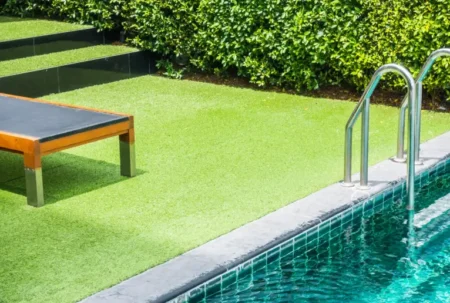 For decades, the American dream came with a green lawn attached — trimmed, watered, and perfectly neat. But lately, something has changed. More and more homeowners are rethinking what “green” really means. Across neighborhoods from California to Florida, traditional grass is quietly giving way to something new: artificial turf.
For decades, the American dream came with a green lawn attached — trimmed, watered, and perfectly neat. But lately, something has changed. More and more homeowners are rethinking what “green” really means. Across neighborhoods from California to Florida, traditional grass is quietly giving way to something new: artificial turf.
The Problem with Real Grass
There’s no denying it — natural lawns look great, but they demand a lot. Endless mowing, watering, fertilizing, and patching eat up both time and money. In states where droughts and water restrictions have become part of life, keeping grass alive starts to feel like a losing battle.
The average U.S. household uses thousands of gallons of water each year just to keep a lawn green. Add to that the gas for mowers, the chemicals for weeds, and the labor involved, and you begin to realize how much effort goes into maintaining something purely for appearance.
That’s why homeowners have started asking a simple question: is there a better way to have a beautiful yard without the waste?
The Rise of Artificial Turf
Artificial turf used to have a bad reputation — plastic-looking grass that belonged on sports fields, not in backyards. But technology has come a long way. Modern turf feels soft, looks real, and handles weather like a pro. It doesn’t fade in the Florida sun or turn to mud after heavy rain.
For families, it means kids and pets can play outside year-round without tracking dirt into the house. For homeowners, it means a yard that looks freshly manicured every day without constant work.
There’s also a growing environmental argument. Fewer chemicals, less water, and no gas-powered mowers make artificial turf an eco-conscious choice. It’s not about faking nature — it’s about adapting to it.
If you live in the Tampa Bay area and want to see how realistic turf can look, you can always check Artificial Turf Tampa. They specialize in modern installations that make lawns beautiful and practical at the same time.
Redefining What “Natural” Means
One reason artificial turf is gaining popularity is that people’s idea of “natural beauty” is changing. It’s not about what grows by itself anymore — it’s about what fits modern life. Americans are spending less time maintaining their homes and more time living in them.
A perfectly green yard that doesn’t demand hours of care every weekend feels liberating. You still get the comfort of open space, the coolness underfoot, and the look of fresh grass, but without the constant upkeep.
It’s not about rejecting nature; it’s about respecting your time. Modern living already asks enough from you — your yard shouldn’t be another job.
From Aesthetic to Lifestyle
Turf has also become part of home design. Homeowners are using it in creative ways: rooftop patios, pool decks, children’s play zones, and even indoor gyms. What used to be seen as a substitute for grass has turned into a design element. It brings color, texture, and softness wherever it’s installed.
In cities where space is limited, turf makes outdoor areas feel polished and functional. In coastal areas like Clearwater or Tampa, it survives salt air and heat that would destroy natural grass. That resilience has turned it from a convenience into a statement — a symbol of efficiency and modern taste.
The Long Game
Replacing a lawn with artificial turf isn’t just about convenience; it’s an investment. The upfront cost can seem high, but over time, it pays itself back in savings on water, maintenance, and repairs. You spend less time maintaining and more time enjoying.
And unlike natural grass, it doesn’t wear out unevenly. Good-quality turf lasts for years while staying bright and uniform. For homeowners tired of bare patches, brown spots, or flooding after storms, that reliability feels like peace of mind.
There’s also something quietly satisfying about knowing your yard looks the same in January as it does in July. It’s one less thing to worry about in a world that already moves fast.
The Bottom Line
Artificial turf isn’t about imitation — it’s about evolution. It fits how people actually live today: busy, conscious, and practical. It’s not pretending to be nature; it’s working with it on new terms.
As climate and lifestyles shift, more Americans are choosing simplicity over tradition. They’re learning that a perfect yard doesn’t have to come with constant effort. It just needs to feel good, look right, and last.
That’s what makes this new kind of green so appealing. It’s clean, sustainable, and ready when you are — no watering, no mowing, just peace and a place to breathe.



